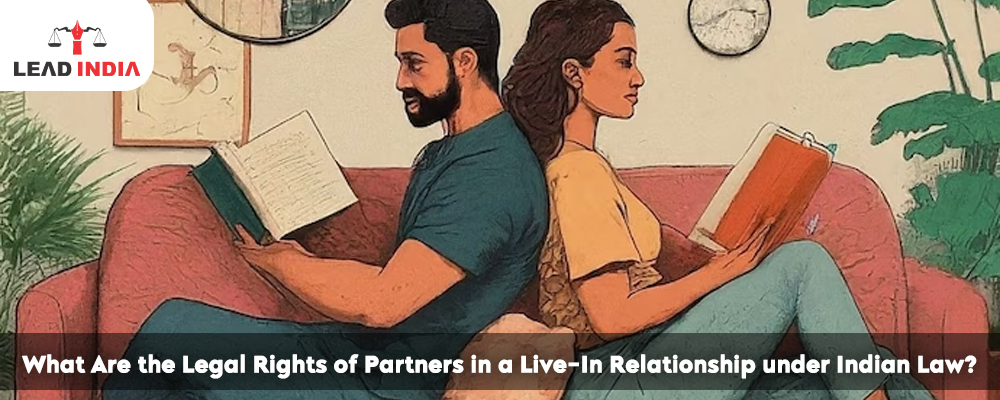The concept of a live-in relationship stems from the widened thought of the people who, over time, began to crave an uncomplicated affair free of strings attached. A living relationship couple is those who cohabitate with a pure understanding with no expectations being the bottom line. On the other hand, however, there is no such legal definition that describes the concept in Indian law. It is more of a Westernised theory with very little relevance to the Indian tradition.
The Indian legal framework does not recognize the Live-in relationships as such. However, the Supreme Court of India has recognized these live-in relationships as legal and granted couples in these relationships some rights and protections.
Need A Legal Advice
The internet is not a lawyer and neither are you. Talk to a real lawyer about your legal issue

Legal Provisions related to live – in Relationship
- These live-in relationships have found constitutional bases in Article 21 of the Constitution of India, which guarantees the right to life and personal liberty. Using its interpretation jurisdiction, the Supreme Court of India has broadened the scope of Article 21 to encompass people’s right to cohabitate with their choice, regardless of marital status.
- Under the Protection of Women from Domestic Violence Act, 2005, Section 2(f) of the Act defines “domestic relationship” to include relationships “like marriage”, thus conferring statutory recognition on live-in relationships. The Act has endowed rights on women in live-in relationships to resort to Redressal mechanisms against domestic violence, which places them at par with married women for the Act.
- Section 144 of BNSS provides for maintenance and has been judicially construed to include women in live-in relationships. In Chanmuniya v. Virendra Kumar Singh Kushwaha (2011), the Supreme Court of India laid down that women in live-in relationships are entitled to claim maintenance under Section 125 of the Code of Criminal Procedure, 1973.
- The Court is permitted to presume the existence of certain facts under Section 114 of the Indian Evidence Act, 1872, including the presumption of marriage in cases of long-term cohabitation. This presumption was judicially applied to protect the rights and interests of partners in live-in relationships, especially in property and maintenance issues.
Legal Rights of Partners in a Live-In Relationship under Indian Law
- In case of breakup, The Supreme Court has held that women in a live-in relationship are entitle to maintenance under the Protection of Women from Domestic Violence Act, 2005. The amount, however, will vary according to the facts of the case. The entitlement to maintenance is possible only when the relationship is find to be the same as a marital relationship on prima facie analysis by the courts on a case-to-case basis.
- There are no automatic rights of couples in a live-in relationship to the property acquired during that relationship, but they can claim a share in the property if they prove they have contributed toward its acquisition or maintenance. According to the Supreme Court of India, based on the case of Velusamy v. D. Patchaiammal (2010), A live-in partner may obtain rights to property built up during the relationship.
- Children born out of live-in relationships, therefore, stand on the same footing as children born of a marriage. Problems relate to custody and alimony, however, are bind to arise in the event of a separation. In the landmark case of Tulsa v. Durghatiya (2008), it was declare by the Supreme Court that children born out of a live-in relationship cannot be term illegal if the parents have spent considerable time within the same roof.
- The Protection of Women from Domestic Violence Act, 2005 extends its protective ambit to women in live-in relationships. Under the said Act, the rights of women involved in live-in relationships include the right to stay in the shared house, The right to seek protection orders against the respondent, and The right to claim compensation for damages suffered as a result of domestic violence.
- Under the Uttarakhand Uniform Civil Code Bill, the Bill defines that a live-in relationship is the cohabitation of a man and a woman in the same household through a relationship in the nature of marriage if such relations are not prohibit. Under Section 378, couples who are in a live-in relationship need to submit a statement of live-in relationship to the registrar of the jurisdiction where they reside. It should be submit within one month of entering into the relationship. Residents of Uttarakhand who are in live-in relationships elsewhere shall also file this declaration with the Registrar of their jurisdiction.
Although live-in relationships have become legalized, they are not binding to couples. It is a huge step forward for society as well, as one can see society accepting something like ‘live-in’.
For any legal help, contact Lead India. We offer free online legal consultations and other legal services. On our platform, you can talk to lawyers. You can freely ask any legal question. We also provide the solutions to all your legal problems.





 Talk to a Lawyer
Talk to a Lawyer